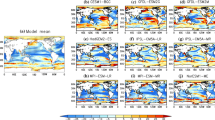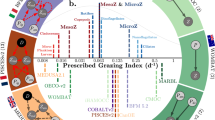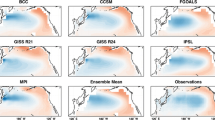Abstract
We analyze for the first time all 16 Coupled Model Intercomparison Project Phase 5 models with explicit marine ecological modules to identify the common mechanisms involved in projected phytoplankton biomass, productivity, and organic carbon export changes over the twenty-first century in the RCP8.5 scenario (years 2080–2099) compared to the historical scenario (years 1980–1999). All models predict decreases in primary and export production globally of up to 30 % of the historical value. We divide the ocean into biomes using upwelling velocities, sea-ice coverage, and maximum mixed layer depths. Models generally show expansion of subtropical, oligotrophic biomes and contraction of marginal sea-ice biomes. The equatorial and subtropical biomes account for 77 % of the total modern oceanic primary production (PP), but contribute 117 % to the global drop in PP, slightly compensated by an increase in PP in high latitudes. The phytoplankton productivity response to climate is surprisingly similar across models in low latitude biomes, indicating a common set of modeled processes controlling productivity changes. Ecological responses are less consistent across models in the subpolar and sea-ice biomes. Inter-hemispheric asymmetries in physical drivers result in stronger climate-driven relative decreases in biomass, productivity, and export of organic matter in the northern compared to the southern hemisphere low latitudes. The export ratio, a measure of the efficiency of carbon export to the deep ocean, decreases across low and mid-latitude biomes and models with more than one phytoplankton type, particularly in the northern hemisphere. Inter-model variability is much higher for biogeochemical than physical variables in the historical period, but is very similar among predicted 100-year biogeochemical and physical changes. We include detailed biome-by-biome analyses, discuss the decoupling between biomass, productivity and export across biomes and models, and present statistical significance and consistency across models using a novel technique based on bootstrapping combined with a weighting scheme based on similarity across models.










Similar content being viewed by others
References
Anav A et al (2013) Evaluating the land and ocean components of the global carbon cycle in the CMIP5 earth system models. J Clim 26:6801–6843. doi:10.1175/jcli-d-12-00417.1
Arora VK et al (2013) Carbon-concentration and carbon-climate feedbacks in CMIP5 earth system models. J Clim 26:5289–5314. doi:10.1175/JCLI-D-12-00494.1
Assmann KM, Bentsen M, Segschneider J, Heinze C (2010) An isopycnic ocean carbon cycle model. Geosci Model Dev 3:143–167
Aumont O, Bopp L (2006) Globalizing results from ocean in situ iron fertilization studies. Global Biogeochem Cycles 20:15. doi:10.1029/2005gb002591
Banse K (1994) Grazing and zooplankton production as key controls of phytoplankton production in the open ocean. Oceanography 7:13–20
Beaulieu C, Henson SA, Sarmiento JL, Dunne JP, Doney SC, Rykaczewski RR, Bopp L (2013) Factors challenging our ability to detect long-term trends in ocean chlorophyll. Biogeosciences 10:2711–2724. doi:10.5194/bg-10-2711-2013
Behrenfeld MJ (2010) Abandoning Sverdrup’s critical depth hypothesis on phytoplankton blooms. Ecology 91(4):977–989
Behrenfeld MJ, Falkowski PG (1997) Photosynthetic rates derived from satellite-based chlorophyll concentration. Limnol Oceanogr 42:1–20
Behrenfeld MJ et al (2006) Climate-driven trends in contemporary ocean productivity. Nature 444:752–755. doi:10.1038/nature05317
Behrenfeld MJ, Doney SC, Lima I, Boss ES, Siegel DA (2013) Annual cycles of ecological disturbance and recovery underlying the subarctic Atlantic spring plankton bloom. Global Biogeochem Cycles 27(2):526–540
Bernardello R, Marinov I, Palter JB, Sarmiento JL, Galbraith ED, Slater RD (2014) Response of the ocean natural carbon storage to projected twenty-first-century climate change. J Clim 27:2033–2053. doi:10.1175/JCLI-D-13-00343.1
Bopp et al (2001) Potential impact of climate change on marine export production. Global Biogeochem Cycles 15(1):81–99. doi:10.1029/1999GB001256
Bopp L, Aumont O, Cadule P, Alvain S, Gehlen M (2005) Response of diatoms distribution to global warming and potential implications: a global model study. Geophys Res Lett 32. doi:10.1029/2005gl023653
Bopp L et al (2013) Multiple stressors of ocean ecosystems in the 21st century: projections with CMIP5 models. Biogeosciences 10:6225–6245. doi:10.5194/bg-10-6225-2013
Boyce DG, Dowd M, Lewis MR, Worma B (2014) Estimating global chlorophyll changes over the past century. Prog Oceanogr 122:163–173. doi:10.1016/j.pocean.2014.01.004
Bryan K, Manabe S, Spelman MJ (1988) Interhemispheric asymmetry in the transient-response of a coupled ocean atmosphere model to a CO2 forcing. J Phys Oceanogr 18:851–867. doi:10.1175/1520-0485(1988
Calbet A, Landry MR (2004) Phytoplankton growth, microzooplankton grazing, and carbon cycling in marine systems. Limnol Oceanogr 49:51–57
Capotondi A, Alexander MA, Bond NA, Curchitser EN, Scott JD (2012) Enhanced upper ocean stratification with climate change in the CMIP3 models. J Geophys Res Oceans 117. doi:10.1029/2011jc007409
Curran MAJ, van Ommen TD, Morgan VI, Phillips KL, Palmer AS (2003) Ice core evidence for Antarctic sea ice decline since the 1950s. Science 302:1203–1206
de Boyer Montégut C, Madec G, Fischer AS, Lazar A, Iudicone D (2004) Mixed layer depth over the global ocean: an examination of profile data and a profile-based climatology. J Geophys Res 109:C12003. doi:10.1029/2004JC002378
Denman KL, Peña MA (1999) A coupled 1-D biological/physical model of the northeast suarctic Pacific Ocean with iron limitation. Deep Sea Res Part II 46:2877–2908
Doney SC (2006) Oceanography—plankton in a warmer world. Nature 444:695–696. doi:10.1038/444695a
Dufresne JL, Quaas J, Boucher O, Denvil S, Fairhead L (2005) Contrasts in the effects on climate of anthropogenic sulfate aerosols between the 20th and the 21st century. Geophys Res Lett 32:L21703. doi:10.1029/2005GL023619
Dunne JP, Armstrong RA, Gnanadesikan A, Sarmiento JL (2005) Empirical and mechanistic models for the particle export ratio. Glob Biogeochem Cycles 19(4). doi:10.1029/2004GB002390
Dunne JP et al (2013) GFDL’s ESM2 global coupled climate-carbon earth system models. Part II: carbon system formulation and baseline simulation characteristics. J Clim 26:2247–2267. doi:10.1175/jcli-d-12-00150.1
Efron B, Tibshirani RJ (1993) An introduction to the bootstrap, 1993. Chapman & Hall, New York
Eyring V et al (2013) Long-term ozone changes and associated climate impacts in CMIP5 simulations. J Geophys Res Atmos 118:5029–5060. doi:10.1002/jgrd.50316
Finkel ZV, Katz ME, Wright JD, Schofield OME, Falkowski PG (2005) Climatically driven macroevolutionary patterns in the size of marine diatoms over the cenozoic. Proc Natl Acad Sci USA 102:8927–8932
Finkel ZV, Beardall J, Flynn KJ, Quigg A, Rees TAV, Raven JA (2010) Phytoplankton in a changing world: cell size and elemental stoichiometry. J Plankton Res 32:119–137
Flato GM, Boer GJ (2001) Warming asymmetry in climate change simulations. Geophys Res Lett 28:195–198. doi:10.1029/2000gl012121
Friedlingstein P et al (2006) Climate-carbon cycle feedback analysis: results from the C4MIP model intercomparison. J Clim 19:3337–3353. doi:10.1175/JCLI3800.1
Friedlingstein P, Meinshausen M, Arora VK, Jones CD, Anav A, Liddicoat SK, Knutti R (2014) Uncertainties in CMIP5 climate projections due to carbon cycle feedbacks. J Clim 27:511–526. doi:10.1175/jcli-d-12-00579.1
Friedman AR, Hwang Y-T, Chiang JCH, Frierson DMW (2013) Interhemispheric temperature asymmetry over the twentieth century and in future projections. J Clim 26:5419–5433. doi:10.1175/jcli-d-12-00525.1
Frierson DMW, Hwang Y (2012) Extratropical influence on ITCZ shifts in slab ocean simulations of global warming. J Clim 25:720–733. doi:10.1175/JCLI-D-11-00116.1
Frölicher TL, Joos F, Plattner GK, Steinacher M, Doney SC (2009) Natural variability and anthropogenic trends in oceanic oxygen in a coupled carbon cycle-climate model ensemble. Glob Biogeochem Cycles 23/GB1003
Fung IY, Doney SC, Lindsay K, John J (2005) Evolution of carbon sinks in a changing climate. Proc Natl Acad Sci USA 102(32):11201–11206. doi:10.1073/pnas.0504949102
Gregg WW (2008) Assimilation of SeaWiFS ocean chlorophyll data into a three-dimensional global ocean model. J Mar Syst 69:205–225. doi:10.1016/j.jmarsys.2006.02.015
Gregg WW, Casey NW, McClain CR (2005) Recent trends in global ocean chlorophyll. Geophys Res Lett 32. doi:10.1029/2004gl021808
Hashioka T et al (2013) Phytoplankton competition during the spring bloom in four plankton functional type models. Biogeosciences 10:6833–6850. doi:10.5194/bg-10-6833-2013
Held I, Soden B (2006) Robust responses of the hydrological cycle to global warming. J Clim 19:5686–5699
Henson SA et al (2010) Detection of anthropogenic climate change in satellite records of ocean chlorophyll and productivity. Biogeosciences 7:621–640
Hutchinson DK, England MH, Santoso A, Hogg AM (2013) Interhemispheric asymmetry in transient global warming: the role of Drake Passage. Geophys Res Lett 40:1587–1593. doi:10.1002/grl.50341
Ilyina T, Six KD, Segschneider J, Maier-Reimer E, Li HM, Nunez-Riboni I (2013) Global ocean biogeochemistry model HAMOCC: model architecture and performance as component of the MPI-Earth system model in different CMIP5 experimental realizations. J Adv Model Earth Syst 5:287–315. doi:10.1029/2012ms000178
Irwin AJ, Oliver MJ (2009) Are ocean deserts getting larger? Geophys Res Lett 36. doi:10.1029/2009gl039883
Jones C (2013) Twenty-first-century compatible CO2 emissions and airborne fraction simulated by CMIP5 earth system models under four representative concentration pathways. J Clim 26. doi:10.1175/JCLI-D-12-00554.1
Kang SM, Frierson DMW, Held IM (2009) The tropical response to extratropical thermal forcing in an idealized GCM: the importance of radiative feedbacks and convective parameterization. J Atmos Sci 66. doi:10.1175/2009JAS2924.1
Knutti R, Sedlacek J (2013) Robustness and uncertainties in the new CMIP5 climate model projections. Nat Clim Change 3:369–373. doi:10.1038/nclimate1716
Knutti R, Furrer R, Tebaldi C, Cermak J, Meehl GA (2010) Challenges in combining projections from multiple climate models. J Clim 23:2739–2758. doi:10.1175/2009jcli3361.1
Le Quéré C et al (2007) Saturation of the Southern Ocean CO2 sink due to recent climate change. Science 316:1735–1738. doi:10.1126/science.1136188
Levitus S (1982) Climatological atlas of the world ocean. NOAA/ERL GFDL Professional Paper 13, NTIS pB83-184093, Princeton, 173 pp
Levitus S, Antonov JI, Boyer TP, Stephens C (2000) Warming of the world ocean. Science 287:2225–2229. doi:10.1126/science.287.5461.2225
Levitus S, Antonov JI, Boyer TP, Locarnini RA, Garcia HE, Mishonov AV (2009) Global ocean heat content 1955–2008 in light of recently revealed instrumentation problems. Geophys Res Lett 36. doi:10.1029/2008gl037155
Longhurst A (1994) Ecological geography of the ocean. Academic Press, San Diego 176 pp
Lovenduski NS, Ito T (2009) The future evolution of the Southern Ocean CO2 sink. J Mar Res 67:597–617
Manabe S, Stouffer RJ (1980) Sensitivity of a global climate model to an increase of CO2 concentration in the atmosphere. J Geophys Res 85:5529–5554
Manabe S, Stouffer RJ, Spelman MJ, Bryan K (1991) Transient responses of a coupled ocean atmosphere model to gradual changes of atmospheric CO2. 1. Annual mean response. J Clim 4:785–818. doi:10.1175/1520-0442(1991)004
Marinov I, Follows M, Gnanadesikan A, Sarmiento JL, Slater RD (2008) How does ocean biology affect atmospheric pCO2? Theory and models. J Geophys Res Oceans 113. doi:10.1029/2007jc004598
Marinov I, Doney SC, Lima ID (2010) Response of ocean phytoplankton community structure to climate change over the 21st century: partitioning the effects of nutrients, temperature and light. Biogeosciences 7:3941–3959. doi:10.5194/bg-7-3941-2010
Marinov I, Doney SC, Lima ID, Lindsay K, Moore JK, Mahowald N (2013) North–south asymmetry in the modeled phytoplankton community response to climate change over the 21st century. Glob Biogeochem Cycles 27. doi:10.1002/2013GB004599
Martinez E, Antoine D, D’Ortenzio F, Gentili B (2009) Climate-driven basin-scale decadal oscillations of oceanic phytoplankton. Science 326:1253–1256. doi:10.1126/science.1177012
Martinez E, Antoine D, D’Ortenzio F, Montegut CD (2011) Phytoplankton spring and fall blooms in the North Atlantic in the 1980s and 2000s. J Geophys Res Oceans 116:11. doi:10.1029/2010jc006836
Massonnet F, Fichefet T, Goosse H, Bitz CM, Philippon-Berthier G, Holland MM, Barriat PY (2012) Constraining projections of summer Arctic sea ice. Cryosphere 6:1383–1394. doi:10.5194/tc-6-1383-2012
Meehl GA et al (2007) The WCRP CMIP3 multimodel dataset—a new era in climate change research. Bull Am Meteorol Soc 88:1383–1394
Meijers AJS, Shuckburgh E, Bruneau N, Sallee JB, Bracegirdle TJ, Wang Z (2012) Representation of the Antarctic circumpolar current in the CMIP5 climate models and future changes under warming scenarios. J Geophys Res Oceans 117. doi:10.1029/2012jc008412
Misumi K, Lindsay K, Moore JK, Doney SC, Bryan FO, Tsumune D, Yoshida Y (2014) The iron budget in ocean surface waters in the 20th and 21st centuries: projections by the community earth system model version 1. Biogeosciences 11:33–55. doi:10.5194/bg-11-33-2014
Moore JK, Doney SC, Lindsay K (2004) Upper ocean ecosystem dynamics and iron cycling in a global three-dimensional model. Glob Biogeochem Cycles 18. doi:10.1029/2004gb002220
Moore JK, Doney SC, Lindsay K, Mahowald N, Michaels AF (2006) Nitrogen fixation amplifies the ocean biogeochemical response to decadal timescale variations in mineral dust deposition. Tellus B 58:560–572. doi:10.1111/j.1600-0889.2006.00209.x
Moore CM et al (2013) Processes and patterns of oceanic nutrient limitation. Nat Geosci 6:701–710. doi:10.1038/ngeo1765
Nakićenović N, Swart R et al (2000) IPCC SRES special report on emissions scenarios: a special report of Working Group III of the Intergovernmental Panel on Climate Change. Cambridge University Press. ISBN:0-521-80081-1, 978-052180081-5. pb:0-521-80493-0, 978-052180493-6
Palmer JR, Totterdell IJ (2001) Production and export in a global ocean ecosystem model. Deep Sea Res Part I Oceanogr Res Pap 48:1169–1198. doi:10.1016/s0967-0637(00)00080-7
Polovina JJ, Howell EA, Abecassis M (2008) Ocean’s least productive waters are expanding. Geophys Res Lett 35. doi:10.1029/2007gl031745
Polvani LM, Previdi M, Deser C (2011) Large cancellation, due to ozone recovery, of future Southern Hemisphere atmospheric circulation trends. Geophys Res Lett 38. doi:10.1029/2011gl046712
Popova EE et al (2012) What controls primary production in the Arctic Ocean? Results from an intercomparison of five general circulation models with biogeochemistry. J Geophys Res Oceans 117. doi:10.1029/2011jc007112
Riahi K et al (2011) RCP 8.5—a scenario of comparatively high greenhouse gas emissions. Clim Change 109:33–57. doi:10.1007/s10584-011-0149-y
Riebesell U, Kortzinger A, Oschlies A (2009) Sensitivities of marine carbon fluxes to ocean change. Proc Natl Acad Sci USA 106(49):20602–20609. doi:10.1073/pnas.0813291106
Russell JL, Stouffer RJ, Dixon KW (2006) Intercomparison of the Southern Ocean circulations in IPCC coupled model control simulations. J Clim 19:4560–4575. doi:10.1175/jcli3869.1
Sallee JB, Shuckburgh E, Bruneau N, Meijers AJS, Bracegirdle TJ, Wang Z (2013) Assessment of Southern Ocean mixed-layer depth in CMIP5 models: historical bias and forcing response. J Geophys Res: Oceans 118(4):1845–1862. doi:10.1002/jgrc.20157
Sarmiento JL et al (2004a) Response of ocean ecosystems to climate warming. Glob Biogeochem Cycles 18. doi:10.1029/2003gb002134
Sarmiento JL, Dunne J, Amstrong RA (2004b) Do we now understand the ocean’s biological pump? US JGOFS News 12(4)
Schmittner A, Oschlies A, Matthews HD, Galbraith ED (2008) Future changes in climate, ocean circulation, ecosystems, and biogeochemical cycling simulated for a business-as-usual CO2 emission scenario until year 4000AD. Glob Biogeochem Cycles 22. doi:10.1029/2007GB002953
Seferian R et al (2013) Skill assessment of three earth system models with common marine biogeochemistry. Clim Dyn 40:2549–2573. doi:10.1007/s00382-012-1362-8
Serreze MC, Holland MM, Stroeve J (2007) Perspectives on the Arctic’s shrinking sea-ice cover. Science 315:1533–1536. doi:10.1126/science.1139426
Simpkins GR, Karpechko AY (2012) Sensitivity of the southern annular mode to greenhouse gas emission scenarios. Clim Dyn 38(3–4):563–572. doi:10.1007/s00382-011-1121-2
Solomon S, Qin D, Manning M, Chen Z, Marquis M, Averyt KB, Tignor M, Miller HL (2007) Contribution of Working Group I to the fourth assessment report of the Intergovernmental Panel on Climate Change. Cambridge University Press, Cambridge
Steinacher M et al (2010) Projected 21st century decrease in marine productivity: a multi-model analysis. Biogeosciences 7:979–1005
Stocker TF et al (2013) IPCC, 2013: Climate change 2013: the physical science basis. Contribution of Working Group I to the fifth assessment report of the Intergovernmental Panel on Climate Change. Cambridge University Press, Cambridge, 1535 pp
Stroeve JC, Kattsov V, Barrett A, Serreze M, Pavlova T, Holland M, Meier WN (2012) Trends in Arctic sea ice extent from CMIP5, CMIP3 and observations. Geophys Res Lett 39:7. doi:10.1029/2012gl052676
Strong C, Davis RE (2007) Winter jet stream trends over the Northern Hemisphere Quarterly. J R Meteorol Soc 133:2109–2115. doi:10.1002/qj.171
Swart NC, Fyfe JC (2012) Observed and simulated changes in the Southern Hemisphere surface westerly wind-stress. Geophys Res Lett 39:L16711. doi:10.1029/2012GL052810
Taucher J, Oschlies A (2011) Can we predict the direction of marine primary production change under global warming? Geophys Res Lett 38. doi:10.1029/2010GL045934
Taylor KE, Stouffer RJ, Meehl GA (2012) An overview of CMIP5 and the experiment design. Bull Am Meteorol Soc 93:485–498. doi:10.1175/bams-d-11-00094.1
Tebaldi C, Arblaster JM, Knutti R (2011) Mapping model agreement on future climate projections. Geophys Res Lett 38. doi:10.1029/2011gl049863
Thompson DWJ, Solomon S (2002) Interpretation of recent Southern Hemisphere climate change. Science 296:895–899. doi:10.1126/science.1069270
Toggweiler JR (2009) Shifting westerlies. Science 323:1434–1435. doi:10.1126/science.1169823
Turner J et al (2009) Non-annular atmospheric circulation change induced by stratospheric ozone depletion and its role in the recent increase of Antarctic sea ice extent. Geophys Res Lett 36. doi:10.1029/2009gl037524
Vancoppenolle M, Bopp L, Madec G, Dunne J, Ilyina T, Halloran PR, Steiner N (2013) Future Arctic Ocean primary productivity from CMIP5 simulations: uncertain outcome, but consistent mechanisms. Global Biogeochem Cycles 27:605–619. doi:10.1002/gbc.20055
Wang MY, Overland JE (2012) A sea ice free summer Arctic within 30 years: an update from CMIP5 models. Geophys Res Lett 39. doi:10.1029/2012gl052868
Watanabe S et al (2011) MIROC-ESM 2010: model description and basic results of CMIP5-20c3 m experiments. Geosci Model Dev 4:845–872. doi:10.5194/gmd-4-845-2011
Xu Y, Ramanathan V (2012) Latitudinally asymmetric response of global surface temperature: implications for regional climate change. Geophys Res Lett 39. doi:10.1029/2012gl052116
Yoder JA, Kennelly MA, Doney SC, Lima ID (2010) Are trends in SeaWiFS chlorophyll time-series unusual relative to historic variability. Acta Oceanol Sin 29:1–4. doi:10.1007/s13131-010-0016-o
Yoshimori M, Broccoli AJ (2009) On the link between Hadley circulation changes and radiative feedback processes. Geophys Res Lett 36:L20703. doi:10.1029/2009GL040488
Yukimoto S et al (2011) Meteorological Research Institute-Earth System Model Version 1 (MRI-ESM1)—model description, meteorological reports of the Meteorological Research Institute, 64
Zahariev K, Christian JR, Denman KL (2008) Preindustrial, historical, and fertilization simulations using a global ocean carbon model with new parameterizations of iron limitation, calcification, and N-2 fixation. Prog Oceanogr 77:56–82. doi:10.1016/j.pocean.2008.01.007
Zunz V, Goosse H, Massonnet F (2013) How does internal variability influence the ability of CMIP5 models to reproduce the recent trend in Southern Ocean sea ice extent? Cryosphere 7:451–468. doi:10.5194/tc-7-451-2013
Zwally HJ, Comiso JC, Parkinson CL, Cavalieri DJ, Gloersen P (2002) Variability of Antarctic sea ice 1979–1998. J Geophys Res Oceans 107. doi:10.1029/2000jc000733
Acknowledgments
A. C. and I. M. acknowledge support by NASA ROSES grant NNX13AC92G and a University of Pennsylvania research foundation grant.
Author information
Authors and Affiliations
Corresponding author
Electronic supplementary material
Below is the link to the electronic supplementary material.
Rights and permissions
About this article
Cite this article
Cabré, A., Marinov, I. & Leung, S. Consistent global responses of marine ecosystems to future climate change across the IPCC AR5 earth system models. Clim Dyn 45, 1253–1280 (2015). https://doi.org/10.1007/s00382-014-2374-3
Received:
Accepted:
Published:
Issue Date:
DOI: https://doi.org/10.1007/s00382-014-2374-3




